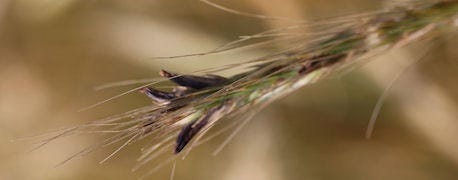August 22, 2013

Cattle producers should be on the lookout for ergot, a fungus in grasses that causes circulatory problems in livestock that consume them.
Richard Randle, a University of Nebraska-Lincoln beef veterinarian, says there have unconfirmed reports of ergot poisoning in Nebraska, as well as confirmed reports in Missouri and Iowa.
Cool and wet spring conditions are key to ergot's presence. Early moisture followed by heat causes certain grasses – especially rye, but also brome, wheatgrass and others – to grow quickly and develop seed heads faster than cattle can consume them. Ergot then can move in and infect the seed heads.

Conditions ripe for ergot poisoning in cattle pastures (SD State University photo)
Ergot appears larger than typical seedheads, usually dark brown, purple to black.
While ergot does not affect meat from cattle, ergot's toxin can reduce blood flow and accumulate over time in live animals if small amounts are eaten regularly. It's poisonous to cattle and other ruminants, llamas and alpacas, horses, swine, dogs and humans, according to the University of Missouri.
UNL recommends producers watch their animals ear tips and tails, as the fungus can shut off the blood flow to extremities, Randle said. As it progresses, it can affect the feet of cattle, causing them to become lame, or cause swelling in the tops of hooves. Rear legs are typically most affected.
Ergot poisoning is usually not fatal itself – if cattle are removed from the source of the fungus, they are likely to recover. However, Randle warns that it can make cattle less tolerant of heat.
For more, read: Farmers, Ranchers Faced With Ergot Issues This Summer
You May Also Like




